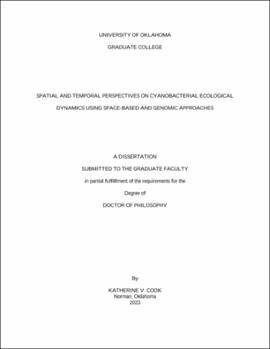| dc.description.abstract | Toxin-producing cyanobacteria, a type of blue-green algae, rank high among the global problems facing aquatic systems. Under certain conditions, particularly elevated nutrient concentrations created by agricultural and urban runoff, as well as altered temperature regimes driven by changing climate, cyanobacteria can form ecosystem disrupting blooms. Their toxins produce chemicals that are harmful, not only to other aquatic organisms, but to humans, pets, and terrestrial wildlife that come into contact with cyanobacterial toxins in water bodies. As such, harmful cyanobacteria blooms threaten freshwaters used for recreation, fisheries, and drinking water. Given the intricate dependency of humanity on water, and the concentration of population centers surrounding lakes and reservoirs, it is imperative that we find new and innovative ways to detect, monitor, manage, and mitigate cyanobacteria blooms. My research addresses these needs in multiple, but complimentary ways, and considers scales that range from satellite data that provides a vantage of blooms from hundreds of kilometers away, to next generation sequencing data that provides a view of how bloom communities form at the genomic level.
In my first two chapters, I search for the existence of a cyanobacteria-bacteria interactome. Cyanobacteria have evolved very small genomes compared to eukaryotes, and thus trade a reduced set of metabolic functions for energy savings during replication. It has been hypothesized that cyanobacteria rely on other bacteria in the community to perform these “lost” metabolic functions. This interaction between the cyanobacterial-bacterial community is termed an interactome and understanding this relationship could help us create innovative biological mitigation strategies in the future.
In chapter one, as an initial test of the cyanobacteria-bacteria interactome hypothesis, I examined a globally occurring, colonial cyanobacterium, Microcystis aeruginosa, and its associated bacteria, testing the hypothesis that if Microcystis depends on bacteria for certain metabolic functions, then geographically distinct Microcystis blooms should harbor similar bacterial microbiome communities and metabolic functions. While I found that the bacteria species were different across nine lakes, the metabolic functions contributed by the associated bacteria were similar across globally distributed lakes, thus supporting the cyanobacteria-interactome hypothesis.
In chapter two, I focused on the hypothesized interactome of a different bloom forming cyanobacteria, Raphidiopsis. Unlike Microcystis, which has a mucilaginous outer layer that harbors a community of bacteria in close physical proximity to its cells, Raphidiopsis is a filamentous cyanobacteria, forming distinct multicellular trichomes with no sheath. I hypothesized if Raphidiopsis selects for certain bacteria, this would result in greater similarity in bacterial microbiome community composition within bloom phases than across bloom phases in the same year. After examining three years of bloom data, I found that bacterial communities associated with Raphidiopsis blooms were more similar to other communities in the same phase than communities within the same year. These results point toward Raphidiopsis selection of associated bacteria and are a first step in providing evidence for the existence of a co-evolved interactome.
In my third chapter, I move from genomes to satellites to explore rapid and accurate ways of detecting and monitoring cyanobacteria blooms. Rigorous monitoring for harmful cyanobacteria blooms is necessary to manage risks to animal and human health, but is often expensive and time-consuming. Remote sensing using satellite- and ground-based platforms has the potential to allow frequent and cost-effective monitoring of cyanobacterial blooms on lakes. Here, I test the capacity of satellite- and ground-based sensors to accurately predict cyanobacteria blooms in Oklahoma. Contrary to research on larger, natural lakes, I found Landsat satellite models performed poorly and were unable to accurately detect blooms in Oklahoma reservoirs. The ground-based models, on the other hand, were highly accurate at detecting blooms. My results indicate alternatives to satellites, like ground-based sensors, should be further explored as reliable and inexpensive tools for monitoring harmful cyanobacteria blooms on large numbers of small lakes and reservoirs. | en_US |
